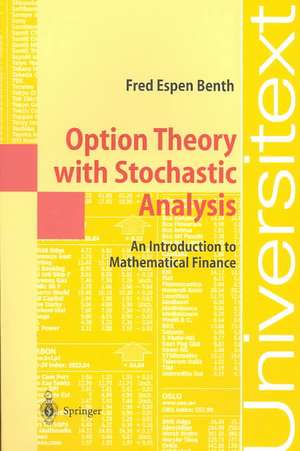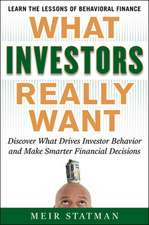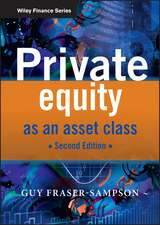Option Theory with Stochastic Analysis: An Introduction to Mathematical Finance: Universitext
Autor Fred Espen Benthen Limba Engleză Paperback – 26 noi 2003
Din seria Universitext
- 13%
 Preț: 353.48 lei
Preț: 353.48 lei -
 Preț: 487.96 lei
Preț: 487.96 lei - 15%
 Preț: 543.75 lei
Preț: 543.75 lei -
 Preț: 418.67 lei
Preț: 418.67 lei - 20%
 Preț: 628.22 lei
Preț: 628.22 lei -
 Preț: 322.62 lei
Preț: 322.62 lei - 17%
 Preț: 364.81 lei
Preț: 364.81 lei -
 Preț: 634.38 lei
Preț: 634.38 lei - 17%
 Preț: 427.32 lei
Preț: 427.32 lei - 13%
 Preț: 355.51 lei
Preț: 355.51 lei - 17%
 Preț: 431.50 lei
Preț: 431.50 lei - 19%
 Preț: 429.21 lei
Preț: 429.21 lei - 19%
 Preț: 393.80 lei
Preț: 393.80 lei -
 Preț: 360.07 lei
Preț: 360.07 lei -
 Preț: 358.44 lei
Preț: 358.44 lei - 13%
 Preț: 389.95 lei
Preț: 389.95 lei -
 Preț: 465.61 lei
Preț: 465.61 lei -
 Preț: 371.98 lei
Preț: 371.98 lei - 15%
 Preț: 497.21 lei
Preț: 497.21 lei - 15%
 Preț: 737.46 lei
Preț: 737.46 lei - 17%
 Preț: 394.41 lei
Preț: 394.41 lei - 15%
 Preț: 509.58 lei
Preț: 509.58 lei - 17%
 Preț: 427.68 lei
Preț: 427.68 lei - 8%
 Preț: 495.43 lei
Preț: 495.43 lei - 17%
 Preț: 364.56 lei
Preț: 364.56 lei - 17%
 Preț: 369.06 lei
Preț: 369.06 lei -
 Preț: 396.53 lei
Preț: 396.53 lei - 15%
 Preț: 553.33 lei
Preț: 553.33 lei - 17%
 Preț: 365.34 lei
Preț: 365.34 lei -
 Preț: 356.77 lei
Preț: 356.77 lei -
 Preț: 673.45 lei
Preț: 673.45 lei - 17%
 Preț: 426.76 lei
Preț: 426.76 lei - 20%
 Preț: 569.54 lei
Preț: 569.54 lei -
 Preț: 372.86 lei
Preț: 372.86 lei -
 Preț: 319.07 lei
Preț: 319.07 lei -
 Preț: 379.86 lei
Preț: 379.86 lei -
 Preț: 445.88 lei
Preț: 445.88 lei -
 Preț: 382.36 lei
Preț: 382.36 lei - 15%
 Preț: 533.72 lei
Preț: 533.72 lei - 15%
 Preț: 496.02 lei
Preț: 496.02 lei - 15%
 Preț: 474.82 lei
Preț: 474.82 lei -
 Preț: 389.70 lei
Preț: 389.70 lei -
 Preț: 484.08 lei
Preț: 484.08 lei - 15%
 Preț: 643.48 lei
Preț: 643.48 lei -
 Preț: 415.02 lei
Preț: 415.02 lei - 15%
 Preț: 602.25 lei
Preț: 602.25 lei - 20%
 Preț: 510.24 lei
Preț: 510.24 lei - 15%
 Preț: 588.37 lei
Preț: 588.37 lei -
 Preț: 381.59 lei
Preț: 381.59 lei
Preț: 448.76 lei
Nou
Puncte Express: 673
Preț estimativ în valută:
85.87€ • 90.13$ • 71.27£
85.87€ • 90.13$ • 71.27£
Carte tipărită la comandă
Livrare economică 10-24 aprilie
Preluare comenzi: 021 569.72.76
Specificații
ISBN-13: 9783540405023
ISBN-10: 354040502X
Pagini: 180
Ilustrații: X, 162 p. 1 illus.
Dimensiuni: 155 x 235 x 9 mm
Greutate: 0.28 kg
Ediția:Softcover reprint of the original 1st ed. 2004
Editura: Springer Berlin, Heidelberg
Colecția Springer
Seria Universitext
Locul publicării:Berlin, Heidelberg, Germany
ISBN-10: 354040502X
Pagini: 180
Ilustrații: X, 162 p. 1 illus.
Dimensiuni: 155 x 235 x 9 mm
Greutate: 0.28 kg
Ediția:Softcover reprint of the original 1st ed. 2004
Editura: Springer Berlin, Heidelberg
Colecția Springer
Seria Universitext
Locul publicării:Berlin, Heidelberg, Germany
Public țintă
GraduateCuprins
1 Introduction.- 1.1 An Introduction to Options in Finance.- 1.2 Some Useful Material from Probability Theory.- 2 Statistical Analysis of Data from the Stock Market.- 2.1 The Black & Scholes Model.- 2.2 Logarithmic Returns from Stocks.- 2.3 Scaling Towards Normality.- 2.4 Heavy-Tailed and Skewed Logreturns.- 2.5 Logreturns and the Normal Inverse Gaussian Distribution.- 2.6 An Alternative to the Black & Scholes Model.- 2.7 Logreturns and Autocorrelation.- 2.8 Conclusions Regarding the Choice of Stock Price Model.- 3 An Introduction to Stochastic Analysis.- 3.1 The Itô Integral.- 3.2 The Itô Formula.- 3.3 Geometric Brownian Motion as the Solution of a Stochastic Differential Equation.- 3.4 Conditional Expectation and Martingales.- 4 Pricing and Hedging of Contingent Claims.- 4.1 Motivation from One-Period Markets.- 4.2 The Black & Scholes Market and Arbitrage.- 4.3 Pricing and Hedging of Contingent Claims X= f(S(T)).- 4.4 The Girsanov Theorem and Equivalent Martingale Measures.- 4.5 Pricing and Hedging of General Contingent Claims.- 4.6 The Markov Property and Pricing of General Contingent Claims.- 4.7 Contingent Claims on Many Underlying Stocks.- 4.8 Completeness, Arbitrage and Equivalent Martingale Measures.- 4.9 Extensions to Incomplete Markets.- 5 Numerical Pricing and Hedging of Contingent Claims.- 5.1 Pricing and Hedging with Monte Carlo Methods.- 5.2 Pricing and Hedging with the Finite Difference Method.- A Solutions to Selected Exercises.- References.
Recenzii
From the reviews:
"This is a … book concerned solely with describing the mathematics of option pricing and I found it a delight to read. It is very well written, quite comprehensive and non-rigorous so that it can be used on courses aimed at a variety of students. … The book includes a healthy number of exercises and there are fully worked solutions to most of these." (David Applebaum, The Mathematical Gazette, Vol. 90 (517), 2006)
"The book provides an introduction to the basic ideas of the mathematical theory of financial options valuation, or, more concretely, to the Black-Scholes theory of pricing contingent claims on equity. … The text is a brief, neat, carefully written introduction to the fundamentals of the mathematics and the modelling of the analysis of options pricing." (José Lúis Fernandez Perez, Zentralblatt MATH, Vol. 1042 (17), 2004)
"This is a … book concerned solely with describing the mathematics of option pricing and I found it a delight to read. It is very well written, quite comprehensive and non-rigorous so that it can be used on courses aimed at a variety of students. … The book includes a healthy number of exercises and there are fully worked solutions to most of these." (David Applebaum, The Mathematical Gazette, Vol. 90 (517), 2006)
"The book provides an introduction to the basic ideas of the mathematical theory of financial options valuation, or, more concretely, to the Black-Scholes theory of pricing contingent claims on equity. … The text is a brief, neat, carefully written introduction to the fundamentals of the mathematics and the modelling of the analysis of options pricing." (José Lúis Fernandez Perez, Zentralblatt MATH, Vol. 1042 (17), 2004)
Textul de pe ultima copertă
The objective of this textbook is to provide a very basic and accessible introduction to option pricing, invoking only a minimum of stochastic analysis. Although short, it covers the theory essential to the statistical modeling of stocks, pricing of derivatives (general contingent claims) with martingale theory, and computational finance including both finite-difference and Monte Carlo methods. The reader is led to an understanding of the assumptions inherent in the Black & Scholes theory, of the main idea behind deriving prices and hedges, and of the use of numerical methods to compute prices for exotic contracts. Finally, incomplete markets are also discussed, with references to different practical/theoretical approaches to pricing problems in such markets.
The author's style is compact and to-the-point, requiring of the reader only basic mathematical skills. In contrast to many books addressed to an audience with greater mathematical experience, it can appeal to many practitioners, e.g. in industry, looking for an introduction to this theory without too much detail.
It dispenses with introductory chapters summarising the theory of stochastic analysis and processes, leading the reader instead through the stochastic calculus needed to perform the basic derivations and understand the basic tools
It focuses on ideas and methods rather than full rigour, while remaining mathematically correct.
The text aims at describing the basic assumptions (empirical finance) behind option theory, something that is very useful for those wanting actually to apply this. Further, it includes a big section on pricing using both the pde-approach and the martingale approach (stochastic finance).
Finally, the reader is presented the two main approaches for numerical computation of option prices (computational finance). In this chapter, Visual Basic code is supplied for all methods, in the form of an add-in for Excel.
The book can be used at an introductory level in Universities. Exercises (with solutions) are added after each chapter.
The author's style is compact and to-the-point, requiring of the reader only basic mathematical skills. In contrast to many books addressed to an audience with greater mathematical experience, it can appeal to many practitioners, e.g. in industry, looking for an introduction to this theory without too much detail.
It dispenses with introductory chapters summarising the theory of stochastic analysis and processes, leading the reader instead through the stochastic calculus needed to perform the basic derivations and understand the basic tools
It focuses on ideas and methods rather than full rigour, while remaining mathematically correct.
The text aims at describing the basic assumptions (empirical finance) behind option theory, something that is very useful for those wanting actually to apply this. Further, it includes a big section on pricing using both the pde-approach and the martingale approach (stochastic finance).
Finally, the reader is presented the two main approaches for numerical computation of option prices (computational finance). In this chapter, Visual Basic code is supplied for all methods, in the form of an add-in for Excel.
The book can be used at an introductory level in Universities. Exercises (with solutions) are added after each chapter.
Caracteristici
Very concise, requires only basic mathematical skills Describes the basic assumptions (empirical finance) underlying option theory Includes a big section on pricing using both pde-approach and martingale approach (stochastic finance) Presents the two main approaches for numerical computation of option prices (computational finance) Can be used at introductory level at universities, with exercises after each chapter Potential interest for the German actuaries and actuarial training













